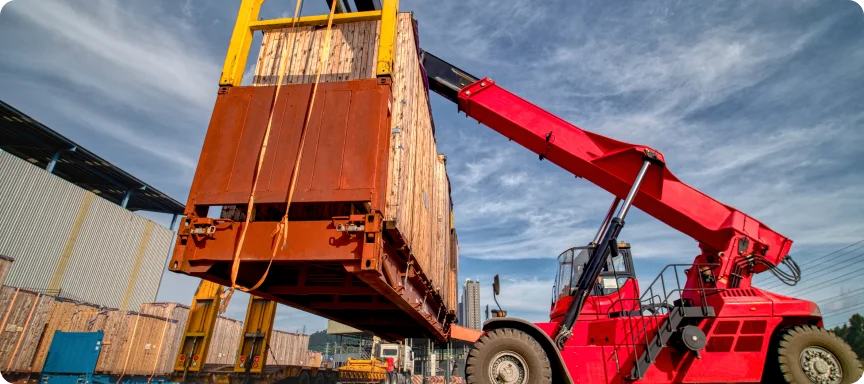
Shiplux
Heavy Equipment Transport
Looking for heavy equipment transport companies? Trust the vehicle transportation professionals at ShipLux to handle all the details. Request a quote for your heavy equipment hauling today!Heavy Equipment Transport
Heavy Equipment Hauling Services
Leave the heavy lifting to us!
Choose ShipLux for hassle-free Heavy Equipment Transport. Our experienced team of shipping professionals will take care of all the logistics, leaving you with the simple task of specifying the drop-off location.
Wave stress away when you ship heavy equipment with ShipLux, as we not only understand but appreciate that "heavy equipment" encompasses equipment in a wide range of sizes and weights. Regardless of the dimensions or weight of your heavy equipment, we have the perfect trailer to transport it.
Shipping heavy equipment requires careful planning and expertise to ensure a smooth and secure heavy equipment hauling process. At ShipLux, we specialize in handling the logistics of shipping heavy equipment of all sizes and weights. We provide a comprehensive range of services, including proper loading and securing techniques, obtaining necessary permits and documentation, and selecting the most suitable trailers or carriers for safe transportation. Our top priority is to deliver your heavy equipment to its destination efficiently and without hassle. Trust ShipLux to handle the complexities of shipping heavy equipment, ensuring a reliable and stress-free experience from start to finish.
Choose ShipLux for hassle-free Heavy Equipment Transport. Our experienced team of shipping professionals will take care of all the logistics, leaving you with the simple task of specifying the drop-off location.
Wave stress away when you ship heavy equipment with ShipLux, as we not only understand but appreciate that "heavy equipment" encompasses equipment in a wide range of sizes and weights. Regardless of the dimensions or weight of your heavy equipment, we have the perfect trailer to transport it.
Shipping heavy equipment requires careful planning and expertise to ensure a smooth and secure heavy equipment hauling process. At ShipLux, we specialize in handling the logistics of shipping heavy equipment of all sizes and weights. We provide a comprehensive range of services, including proper loading and securing techniques, obtaining necessary permits and documentation, and selecting the most suitable trailers or carriers for safe transportation. Our top priority is to deliver your heavy equipment to its destination efficiently and without hassle. Trust ShipLux to handle the complexities of shipping heavy equipment, ensuring a reliable and stress-free experience from start to finish.
What Equipment Do We Ship?
Whether it's construction machinery, industrial equipment, or oversized vehicles, our dedicated team of professionals is well-equipped to handle the unique requirements of each shipment!
This includes:
Don't see what you are looking to ship? Contact us to talk about our options!
This includes:
- Commercial equipment, including Tractor shipping
- Industrial equipment
- Commercial bus equipment
- Construction equipment
- Agricultural equipment shipping
- Over dimensional transport
- Mining equipment hauling
- Freight container shipping
- Farm equipment transport
- Oversize load equipment shipping
- Heavy duty trucks
Don't see what you are looking to ship? Contact us to talk about our options!

Types of Trailers We Offer
Preparing Heavy Equipment For Shipping
- Assessment and documentation
Firstly, you'll want to conduct a thorough assessment of the equipment. Take your time and carefully evaluate its condition. Check for any existing damages, wear, and tear, or potential issues. This assessment will give you a clear picture of the equipment's current state. Now, here's a pro tip: grab your camera and start snapping away! Take plenty of photographs of the equipment from various angles. These photos will serve as solid evidence of the equipment's condition before it embarks on its journey. Then, gather all the necessary documentation for the transportation process. This includes ownership papers, permits, licenses, or any other legal documents that are required. Double-check that you have everything in order, so there are no hiccups or delays when it comes time to ship your equipment. - Cleaning and disassembly
Equipment should be cleaned thoroughly to remove any dirt, debris, and hazardous materials. Disassemble removable parts and accessories, securely packaging and labeling them for easy identification. - Securing and protecting
Properly secure loose or fragile components to prevent damage during transit. Protect vulnerable areas by using appropriate padding, covering, or wrapping materials. Ensure that all doors, windows, and access points are securely closed and locked. - Drain fluids and disconnect batteries
Drain fuel, oil, coolant, and other fluids from the equipment to prevent leaks or spills during transportation. Disconnect and remove the battery, ensuring it is securely packaged separately. - Loading and securing
Determine the appropriate loading method based on the equipment's size and weight. Utilize cranes, forklifts, or loading ramps to safely load the equipment onto the trailer or shipping container. Use heavy-duty straps, chains, or braces to secure the equipment and prevent shifting during transit. - Documentation and insurance
Complete all required shipping documentation accurately, including shipping labels, customs forms, and insurance declarations. Verify that you have adequate insurance coverage to protect against any potential damages or losses during transit.
What To Do After Your Heavy Equipment Transport
Hey, your heavy equipment has finally made it! Exciting, right? Now that it's here, let's go through what you need to do next.
First things first, give your equipment a thorough inspection. Take a good look at every nook and cranny, checking for any signs of damage, scratches, or dents that might have happened during its journey. Compare its condition to the documentation you prepared before shipping, and don't forget to snap some photos for your records.
Now, here's where we come in. One of our team members will ask you to sign the delivery receipt or bill of lading given by the shipping company. It's important to go over all the details and make sure everything is spot-on, including the equipment's condition upon arrival. Hang on to a copy of the signed document so you have it for your peace of mind.
If there are any additional tasks needed after delivery, like reassembly, maintenance, or testing, let us know. We'll help you schedule these activities accordingly to get your equipment up and running smoothly.
So take a moment to inspect, sign, and plan for any post-delivery needs. We're here to assist you every step of the way and make sure your heavy equipment is in top-notch shape.
First things first, give your equipment a thorough inspection. Take a good look at every nook and cranny, checking for any signs of damage, scratches, or dents that might have happened during its journey. Compare its condition to the documentation you prepared before shipping, and don't forget to snap some photos for your records.
Now, here's where we come in. One of our team members will ask you to sign the delivery receipt or bill of lading given by the shipping company. It's important to go over all the details and make sure everything is spot-on, including the equipment's condition upon arrival. Hang on to a copy of the signed document so you have it for your peace of mind.
If there are any additional tasks needed after delivery, like reassembly, maintenance, or testing, let us know. We'll help you schedule these activities accordingly to get your equipment up and running smoothly.
So take a moment to inspect, sign, and plan for any post-delivery needs. We're here to assist you every step of the way and make sure your heavy equipment is in top-notch shape.

Overseas and International Heavy Equipment Transport
Overseas or international heavy equipment transport is something we specialize in, despite the complexity, meticulous planning, and coordination needed.
When shipping heavy equipment across borders or overseas, there are several key considerations to keep in mind. Firstly, it is crucial to research and comply with the import/export regulations and customs requirements of the destination country. This includes obtaining the necessary permits, licenses, and documentation needed for the transportation.
The equipment must be properly packaged and secured. Specialized shipping containers or flat racks may be used to accommodate oversized or irregularly shaped equipment.
Of course, our expert team will happily handle the logistics, arrange for suitable shipping modes, and navigate potential challenges like port regulations and customs clearance, to ensure a smooth and efficient international heavy equipment transport!
The shipment methods we offer are:
When shipping heavy equipment across borders or overseas, there are several key considerations to keep in mind. Firstly, it is crucial to research and comply with the import/export regulations and customs requirements of the destination country. This includes obtaining the necessary permits, licenses, and documentation needed for the transportation.
The equipment must be properly packaged and secured. Specialized shipping containers or flat racks may be used to accommodate oversized or irregularly shaped equipment.
Of course, our expert team will happily handle the logistics, arrange for suitable shipping modes, and navigate potential challenges like port regulations and customs clearance, to ensure a smooth and efficient international heavy equipment transport!
The shipment methods we offer are:
- RoRo Shipping
or roll on, roll off shipping, involves driving heavy equipment onto a specialized vessel using ramps. This method is commonly used for wheeled or self-propelled equipment such as trucks, trailers, or bulldozers. The equipment is securely lashed and parked inside the ship's designated cargo area. Upon reaching the destination, the equipment is driven off the vessel using ramps. - Flat Rack Shipping
is suitable for oversized or irregularly shaped equipment that cannot fit into standard containers. Flat racks are open platforms without sides, allowing flexibility in accommodating large or bulky equipment. The equipment is securely fastened to the flat rack using straps or chains. This method provides stability and protection during transit and is often used for heavy machinery, construction equipment, or oversized vehicles. - Container Shipping
involves placing heavy equipment inside standard shipping containers. This method offers added security and protection from external elements. It is suitable for equipment that can fit within the dimensions of the container. The equipment is loaded into the container at the origin, sealed, and transported via cargo ships. At the destination, the container is unloaded using cranes or forklifts. - LoLo (Lift-On/Lift-Off)
is a method used when heavy equipment cannot be driven onto a vessel. Instead, cranes or other lifting equipment are employed to lift the equipment and place it onboard the ship. This method is commonly used for extremely heavy or non-self-propelled equipment such as large industrial machinery or turbines.